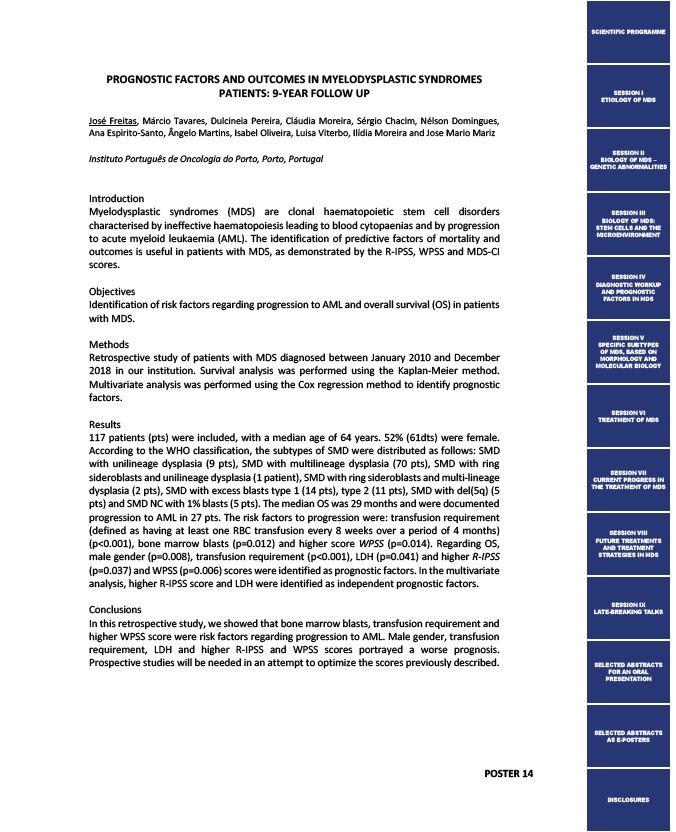
PROGNOSTIC FACTORS AND OUTCOMES IN MYELODYSPLASTIC SYNDROMES
PATIENTS: 9-YEAR FOLLOW UP
José Freitas, Márcio Tavares, Dulcineia Pereira, Cláudia Moreira, Sérgio Chacim, Nélson Domingues,
Ana Espirito-Santo, Ângelo Martins, Isabel Oliveira, Luisa Viterbo, Ilídia Moreira and Jose Mario Mariz
I
nstituto Português de Oncologia do Porto, Porto, Portugal
I
ntroduction
Myelodysplastic syndromes (MDS) are clonal haematopoietic stem cell disorders
characterised by ineffective haematopoiesis leading to blood cytopaenias and by progression
to acute myeloid leukaemia (AML). The identification of predictive factors of mortality and
outcomes is useful in patients with MDS, as demonstrated by the R-IPSS, WPSS and MDS-CI
scores.
Objectives
Identification of risk factors regarding progression to AML and overall survival (OS) in patients
with MDS.
Methods
Retrospective study of patients with MDS diagnosed between January 2010 and December
2018 in our institution. Survival analysis was performed using the Kaplan-Meier method.
Multivariate analysis was performed using the Cox regression method to identify prognostic
factors.
Results
117 patients (pts) were included, with a median age of 64 years. 52% (61dts) were female.
According to the WHO classification, the subtypes of SMD were distributed as follows: SMD
with unilineage dysplasia (9 pts), SMD with multilineage dysplasia (70 pts), SMD with ring
sideroblasts and unilineage dysplasia (1 patient), SMD with ring sideroblasts and multi-lineage
dysplasia (2 pts), SMD with excess blasts type 1 (14 pts), type 2 (11 pts), SMD with del(5q) (5
pts) and SMD NC with 1% blasts (5 pts). The median OS was 29 months and were documented
progression to AML in 27 pts. The risk factors to progression were: transfusion requirement
(defined as having at least one RBC transfusion every 8 weeks over a period of 4 months)
(p<0.001), bone marrow blasts (p=0.012) and higher score WPSS (p=0.014). Regarding OS,
male gender (p=0.008), transfusion requirement (p<0.001), LDH (p=0.041) and higher R-IPSS
(p=0.037) and WPSS (p=0.006) scores were identified as prognostic factors. In the multivariate
analysis, higher R-IPSS score and LDH were identified as independent prognostic factors.
Conclusions
In this retrospective study, we showed that bone marrow blasts, transfusion requirement and
higher WPSS score were risk factors regarding progression to AML. Male gender, transfusion
requirement, LDH and higher R-IPSS and WPSS scores portrayed a worse prognosis.
Prospective studies will be needed in an attempt to optimize the scores previously described.
POSTER 14
SCIENTIFIC PROGRAMME
SESSION I
ETIOLOGY OF MDS
SESSION II
BIOLOGY OF MDS –
GENETIC ABNORMALITIES
SESSION III
BIOLOGY OF MDS:
STEM CELLS AND THE
MICROENVIRONMENT
SESSION IV
DIAGNOSTIC WORKUP
AND PROGNOSTIC
FACTORS IN MDS
SESSION V
SPECIFIC SUBTYPES
OF MDS, BASED ON
MORPHOLOGY AND
MOLECULAR BIOLOGY
SESSION VI
TREATMENT OF MDS
SESSION VII
CURRENT PROGRESS IN
THE TREATMENT OF MDS
SESSION VIII
FUTURE TREATMENTS
AND TREATMENT
STRATEGIES IN MDS
SESSION IX
LATE-BREAKING TALKS
SELECTED ABSTRACTS
FOR AN ORAL
PRESENTATION
SELECTED ABSTRACTS
AS E-POSTERS
DISCLOSURES